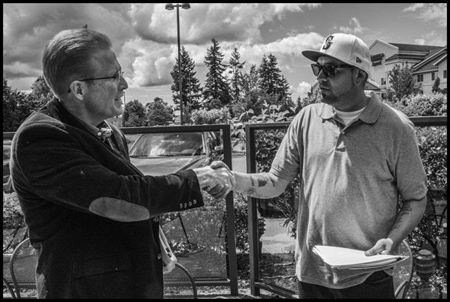
Bob’s Burgers and Brew, a hamburger joint at the Cook Road freeway exit on Interstate 5, about two hours north of Seattle, doesn’t look like a place where Pacific Northwest farm workers can change their lives, much less make some history. But on June 16, a half-dozen men in work clothes pulled tables together in Bob’s outdoor seating area. Danny Weeden, general manager of Sakuma Brothers Farms, then joined them.
After exchanging polite greetings, Weeden opened four folders and handed around copies of a labor contract that had taken 16 sessions of negotiations to hammer out. As the signature pages were passed down the tables, each person signed. Weeden collected his copy and drove off; the workers remained long enough to cheer and take pictures with their fists in the air. Then they too left.
It was a quiet end to four years of strikes and boycotts, in which these workers had organized the first new farm-worker union in the United States in a quarter-century-Familias Unidas por la Justicia (FUJ).
The union itself will not be like most others. At the ratification meeting held the previous night, many of the people packed into the hall of Mt. Vernon’s Unitarian Church spoke with each other in Mixteco or Triqui. Members of Familias Unidas por la Justicia come originally from towns in Oaxaca and southern Mexico where people speak indigenous languages that were centuries old when the Spanish colonized the Americas.
”We are part of a movement of indigenous people,” says Felimon Pineda, FUJ vice president. An immigrant from Jicaral Cocoyan de las Flores in Oaxaca, he says organizing the union is part of a fight against the discrimination indigenous people face in both Mexico and the United States: “Sometimes people see us as being very low. They think we have no rights. They’re wrong. The right to be human is the same.”
According to Rosalinda Guillen, director of Community2Community, an advocacy organization that helped the workers organize, “Indigenous culture plays a huge role, especially people’s collective decision-making process. The strong bonds of culture and language give the union a lot of its strength.”
Sakuma Brothers Farms hires about 450 workers every year to pick its strawberries and blueberries from June through October, in its fields in Burlington and Mt. Vernon, Washington. About half live in the local area, and half come north for the picking season from Santa Maria, Madera, Livingston, and other farm-worker towns in California. The migrants from the south live in the company’s labor camps for the duration of the work.
Almost all Sakuma workers arrived from Mexico years ago, and have been living in the United States ever since. They depend on this seasonal job picking berries for a large part of their yearly income.
In 2013, workers grew angry about a low piece rate and bad conditions in the labor camps, and protested to company managers. One was fired and told to leave the camp where his family was living. The rest of the company’s workers then stopped the harvest to get his job and housing back. In the weeks that followed they began negotiating with the farm’s owners, the Sakuma family. They elected a committee to speak for them, which became the nucleus of Familias Unidas por la Justicia.
In the course of negotiations, the workers discovered that the company had recruited 78 laborers in Mexico, and brought them to the United States under the H2A visa program. These contracted workers could only work for the employer that recruits them, and could only stay for the duration of a work contract limited to several months, after which they had to return to Mexico.
”In 2013, the wages for the H2A workers were $12 an hour, and our wages were $9.37,” says Ramon Torres, one of the original strikers. “When we found that out, our first demand was that we get the same pay.”
Under the H2A program rules, employers have to show they can’t find workers in the United States before they can recruit contract workers abroad. After the 2013 picking season ended, Sakuma Farms sent letters to the workers involved in the work stoppages, saying they’d been terminated for missing work. The farm then applied to the Department of Labor for visas to bring in 479 workers-enough to replace its entire workforce.
Torres calls this a watershed moment for the workers, whose response to Sakuma’s visa request was brilliantly effective. “We wrote letters, to prove to the government that we were ready to work. When people heard that the company was saying that they couldn’t find any workers, everyone signed the letter. Everyone. We filled out 489 letters.”
After union members and supporters handed in the letters at Department of Labor offices in San Francisco, Seattle, Washington, D.C., and Chicago, the company withdrew its application. With no H2A workers to pick the berries, it was forced to rehire the strikers for the 2014 season. “That made our members even stronger in their support for the union,” Torres says. “Everyone understood then that the company wanted to replace us, and that we needed a union to protect ourselves. That made our struggle easier.”
Because Torres, who hails from Guadalajara, speaks Spanish, his coworkers, many of whom only speak Mixteco, asked him to be their spokesperson during those first negotiations. Then they elected him president of Familias Unidas por la Justicia. Today they call him “Homie,” a joking way of saying he shares their life even if not their indigenous culture. When the company fired him in 2013, they remained fiercely loyal; Pineda even quit his own job in solidarity.

In those 2013 negotiations, Torres and the FUJ committee proposed a way to calculate the piece rate that was simpler than the company’s system, and that would produce an average wage of $12 an hour for most workers. The company began to use it. But when workers’ earnings jumped, the company discarded the new way. Over the next four years, workers then mounted work stoppages to force increases in the piece rate.
”Strikes were the easiest way for us to get the company’s attention,” Torres says. “We didn’t have any other way. And strikes helped develop people’s understanding that if we had a union contract, we’d be stronger. Even if we won an increase in the piece rate one day, the company could lower it again the next day. It was a way for us to win over the people.”
When negotiations broke down in 2013, FUJ–resurrecting a tactic from Cesar Chavez’s efforts to organize California’s farm workers–organized a boycott of the company’s berries. “At first the boycott was against Sakuma,” Torres recalls, “and we were able to get their berries taken off the shelves in the markets. Then we saw in the fields that the boxes of the berries didn’t have Sakuma’s label on them anymore. They had the Driscoll’s Berries label instead.”
As the union began boycotting Driscoll’s, it set up committees of supporters in cities in Washington, Oregon, and California. Some committees depended on students to picket stores, while others relied on support from other unions. Members and supporters of FUJ also organized a series of marches (invariably passing by Bob’s Burgers and Brew) to Sakuma’s offices, demanding that Driscoll’s acknowledge their right to better wages and a union contract.
At many of those marches, Jeff Johnson, secretary of the Washington State Labor Federation, AFL-CIO, spoke in support of the farm workers. Other unions helped. “One day the longshore union even refused to load Driscoll’s fruit onto a ship, and left it sitting on the dock,” Torres remembers.
Driscoll’s became a target of farm workers in Mexico as well. In 2015, thousands struck fields in Baja California, where a Driscoll’s subsidiary, BerryMex, is the largest berry grower. Those workers also come from indigenous towns in Oaxaca. Many Sakuma workers have family members working in Baja’s San Quintin Valley, and worked there themselves before coming to the United States. The boycotters demanded higher wages and better conditions for workers in both countries.
The alliances supporting the workers also included an organization of indigenous migrants with chapters in Oaxaca, Baja California, and California-the Binational Front of Indigenous Organizations (FIOB in its Spanish initials). As soon as the strike started in 2013, FIOB’s binational coordinator, Bernardo Ramirez, flew in from Oaxaca to help. His presence dramatized the strike’s importance in Mixteco and Triqui communities. After a meeting at the FIOB office in Fresno, California, the organization helped collect letters from those Sakuma workers who live in California, and travel to Washington for the harvest every year. That helped thwart the farm’s attempt to bring in H2A replacements.
In the fall of 2016, Sakuma Brothers Farms finally announced it was willing to sit down with Familias Unidas por la Justicia, if workers showed they supported the union in an election. There is no law in Washington state like that in California, establishing a process for union elections for farm workers. FUJ and its lawyers had to negotiate a memorandum of understanding with Sakuma, laying out a process for voting.
Torres and Guillen are sure that the reason why Sakuma decided to negotiate was pressure from Driscoll’s.
On September 12, 195 workers voted for the union and 58 against. The company refused to allow the votes to be counted on its property because Torres was present, and the tally was made instead on the bed of a pickup truck in a nearby schoolyard. Commenting on the scope of the communities that supported the workers’ efforts, the AFL-CIO’s Johnson called it “as much a public victory as a union victory.”
Contract negotiations then started between FUJ and Sakuma managers. The new union relied on another labor supporter, Jason Holland of the Washington Public Employees Association, a local unit of the United Food and Commercial Workers. “We’d never done this and didn’t know how to negotiate a contract,” Torres says. “But our members learned who we really were in relation to the company. And in the end we got a lot of what we wanted.”
Primary among the union’s gains in this new contract is the re-establishment, in effect, of the piece-rate system Torres designed four years earlier. Three workers chosen by the union will go into a field to make a “test pick” before the work starts. Depending on the amount of fruit and field conditions, a piece-rate price is then set so that an average worker can make the equivalent of at least $15 per hour. All workers are guaranteed a $12 hourly minimum.
When the system was explained at the meeting before the ratification vote, there were many questions. “It’s a complicated system and I want to understand it better,” said picker Josefina Ortiz. “I’m a slow picker, and I don’t make much. We always want the company to pay more, and the company is always trying to lower the price to make us work hard. We hope we’ll make better [wages] with this new system.”
”The most important thing for us was the wages,” Torres responded. “Our main vision for the contract was to achieve a fair wage of $15 that you could earn without killing yourself. And that was what we won.”
The implementation of any new contract is a difficult process, requiring the company to change old methods, and to recognize the authority of the union. After the first test pick following the signing of the agreement, the union had to file its first grievance, saying the process wasn’t being implemented fairly. Now, however, there is a grievance procedure in place, supplanting the workers’ previous practice of striking over rates they didn’t like.
In addition, the contract contains other protections for workers. One provision requires a just cause for any discipline–a sensitive issue given the firings that took place during the four-year campaign. Eight union representatives will be able to represent members in grievances. A seniority system will ensure that workers doing the work this year will be able to return in following years. The contract will last two years, and a labor-management committee will try to draft a retirement plan for workers by the end of that period.
FUJ members, meanwhile, are filled with ideals, starting with their own organization.
FUJ members, meanwhile, are filled with ideals, starting with their own organization. Its principles for organization sound like those of radical unions throughout U.S. history. Union leaders should be workers, and the rank and file should make all decisions. No leader or staff member should have a salary higher than a worker in the fields. The union shouldn’t accumulate property and large bank accounts. “If there’s money in the union bank account after ten years, it will be given back to the members,” Torres promises. “We don’t want rich unions and poor workers.”
FUJ members’ vision extends beyond the limits of their contract and the structure of their union. They also are planning to acquire land and set up a cooperative farm. They see their union as part of a larger community, and while its members are immigrants, they are not just temporary residents. Over the past four years, Guillen especially has fought the stereotype of immigrant farm workers as transient, unskilled labor. “We’ve always felt that we are invisible people. We’re treated as disposable, and it’s time to end that,” she asserts. “We’re human beings and we’re part of the community.”
From the beginning, workers on other farms on Washington’s Pacific coast with the same dissatisfaction with low wages have talked quietly with Sakuma workers. Many share the indigenous culture of FUJ members. Sakuma Brothers Farms will now have a wage level substantially above the surrounding growers, and FUJ plans to use that to inspire other workers to set up their own independent unions, Torres says.

”That’s the priority-to raise our living standards. We know the contract will change our lives. Now, if we make a little more, our children will have other possibilities. It’s not that we want to take them out of the fields, but we want them to have opportunities other children have.”
Predicted Tomas Ramon, a member of the union negotiating committee: “Things won’t be the same as they were before. We’re a recognized union now, and everything will be different.” To make that difference real, over the next two years FUJ will have to train workers to enforce their own contract at Sakuma Brothers Farms. And to survive, the union will have to help workers organize on other ranches as well. That will require confronting the growing use of H2A workers in Washington state, whose numbers have increased from 2,000 to more than 13,000 in the last five years.
Fifty years ago, the United Farm Workers was built by thousands of farm workers in fields across California, who believed the union spoke for their needs, whether or not they were working under a union contract. Today on the Washington coast, a growing number of field laborers look at FUJ in the same way. It is a small union, with very limited resources. But if it speaks for the needs of Washington farm workers, and those who migrate north from California every season, FUJ, too, may inspire a movement far beyond its own numbers.










